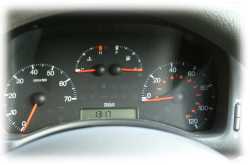Smooth changes
To achieve 'perfect' balance while changing gear you will need to practice several gear changes; this could be several hundred changes, even several thousand!
For some drivers the whole concept of smooth gear changing might be alien.
Your aim is to keep the car balanced throughout the gear change process. No pitching  backwards or forwards and no clutch 'drag' on downward gear changes.
backwards or forwards and no clutch 'drag' on downward gear changes.
You can recognise clutch drag by the sound of the engine - there should be no change in the engine sound as the clutch is engaged (unless the change is made as you press the gas pedal).
In order to eliminate pitching and dragging it's usually easiest to start with 3rd to 4th and 4th to 3rd. If your car has a rev-counter, use it to help match the revs to the speed when making downward gear changes
Co-ordination: Method
Find a clear stretch of road where you can change freely between 3rd and 4th gear. Build your speed up to about 45mph in 4th gear and then change down to 3rd.
To do this smoothly you will need to ease the pressure on the gas pedal very slightly before declutching (this should not noticeably slow the car down). This is done to prevent the car from 'pitching' forward as you declutch.
De-clutch and move the gear lever and start to press the gas pedal before you engage the clutch. Bring the clutch up smoothly as you apply more gas.
When the clutch is brought up fully you should be travelling at about 40mph.
Change back to 4th gear concentrating on smooth clutch control.
Repeat this exercise several times until you are happy with the results.
Accelerator and clutch
The engine rev's should always match the road speed for the gear selected. That is, there should be no discernible jerk (vehicle weight-shift) as a direct result of a gear change.
If the engine 'drones' you need to either adjust the speed at which the gear change is made or increase the engine revs by light accelerator pressure as the clutch is engaged.
 One of the most common problems at this stage is a rushed gear change. Take your time when making gear changes; if you have any problems slow down your hand and feet movements – make the action slow and deliberate, concentrating on what you can feel through the gas pedal and clutch.
One of the most common problems at this stage is a rushed gear change. Take your time when making gear changes; if you have any problems slow down your hand and feet movements – make the action slow and deliberate, concentrating on what you can feel through the gas pedal and clutch.
Feel free to make mistakes at this point - but not jerks! Temporary mistakes such as over-revving or slipping the clutch slightly are OK – they will pass as you relax and start to get a feel for the new style of driving..
Now get out there and practise!
Next: Checklist.